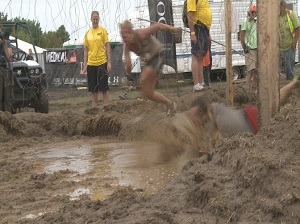NRK reports that some 50 of 300 participants became sick with Campylobacter in a cycling event in Norway.

Competitors at the start of the 2015 Tough Mudder Scotland at Drumlanrig Castle, Dumfries and Galloway
Earlier, several people were stricken by E. coli O157 in a tough mudder event which was held at Drumlanrig Castle in Scotland on June 17 and 18.
These outbreaks follow previous, numerous outbreaks involved with playing in mud.
In Norway, the reason why the cyclists have become so bad is because animal wreckage resolved after a heavy rainfall and remained in the road. This has again sprung up on the cyclists.
“Especially if the stool is fresh and there are large amounts of water, it can sprinkle on drinking bottles and hands so you get it when you drink,” said Tor Halvor Bjørnstad-Tuveng, to NRK (something may be lost in translation).
“We have been in dialogue with the management of the race, and we have some concrete measures that we will look at. We have been very unlucky with the rides of the year, but we must definitely look at what we can do to prevent it happening again, “says Bjørnstad-Tuveng.
Per Stubban was one of those who had to go to the hospital for intravenous nutrition.
“Now I’m on my way, but there have been some tough days. Next time I will not use a handheld drink bottle, but a drinking bag, and if there is as much rain as it was now, I would probably be skeptical to start, “he said.
Participants in an endurance event at a Scottish castle have been warned to look out for symptoms of E. coli O157 after it was identified among those who took part.
 NHS Dumfries and Galloway said “a small number of cases” of the bacteria have been found in those involved in the Tough Mudder event at Drumlanrig Castle last month.
NHS Dumfries and Galloway said “a small number of cases” of the bacteria have been found in those involved in the Tough Mudder event at Drumlanrig Castle last month.
It has advised anyone associated with the event who experiences symptoms to seek medical advice.
A spokesman for the health board said: “NHS Dumfries and Galloway can confirm that we are aware of a small number of cases of E.coli O157 across Scotland that appear to be associated with participation in the Tough Mudder event which was held at Drumlanrig Castle on June 17 and 18.
“Any activity undertaken on agricultural land inevitably involves a small risk of gastrointestinal infection.”
A spokesman for the event said: “The safety of Tough Mudder participants, spectators, volunteers and staff is our number one priority.
Uh-huh.






